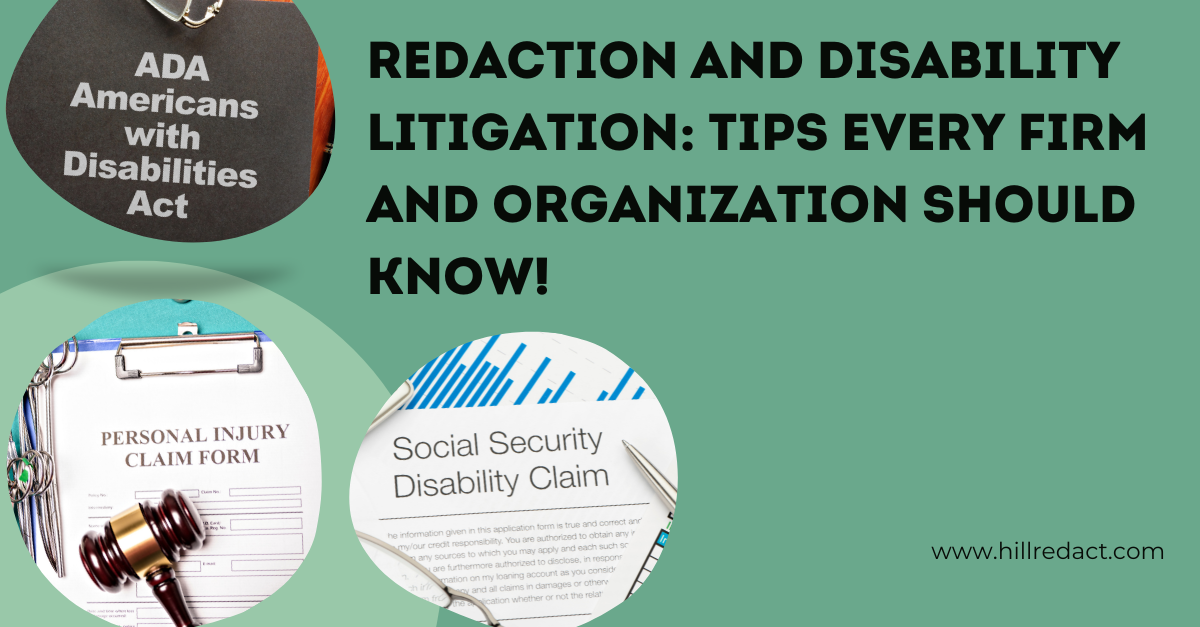
Redaction and Disability Litigation: Tips Every Firm and Organization Should Know!
It’s no secret that redacting disability litigation cases is a strenuous and extremely time-consuming process. Disability, insurance, personal injury, and medical malpractice litigation cases all involve sharing or e-filing medical records and insurance documentation. These types of documents are riddled with Protected Health Information (PHI) and Personally Identifiable Information (PII) and protected by Privacy Act of 1974 and HIPAA. The Social Security Administration details restrictions on exposing sensitive information in these documents. Redaction for firms that handle such cases must be categorized as a top priority.
The large amount of nuanced and descriptive information packed in insurance documents and medical records catapult those documents to the top five most challenging documents to review for redaction. We will briefly discuss some go-to suggestions that can turn the tables for firms and disability advocate organizations struggling with the time-consuming nature of redaction.
Why Redacting In-House is Hurting Your Disability Litigation Case
Redaction is so much more than drawing a black bar over data or running a bunch of documents through automation. The document redaction process is riddled with intricacies that can challenge even the most seasoned legal professionals. Any minor oversight can lead to serious legal and compliance penalties, underlining redaction requires very specific techniques and security protocols.
There have been several studies and statistics that show just how frequent missed redactions occur in the legal industry. In 2017 an alarming 85% of legal professionals admitted to failing to redact sensitive information correctly at least once! I would argue that percentage is much higher today. An article posted with the American Bar Association noted several incidents of missed redactions and their impact. An article in Freedom to Tinker, discusses the federal courts study that estimated potentially tens of thousands of documents were filed with unredacted social security numbers.
It’s important to understand missed redactions aren’t just minor errors; these are potential liabilities lurking in your documents! Statistics show accidental missed redactions are almost impossible to avoid when solely relying on in-house redaction.
Redacting medical and insurance records carry profound legal weight. Sharing or E-filing any of these documents without redacting sensitive data opens you up to accidental data breaches by way of missed redactions.
Redaction Guide & Best Practices
If your firm or organization redacts documents in-house, there are a few steps you can take to ensure accuracy and minimize the risk of missed redactions. The most important step and prerequisite is having a basic and up to date understanding of privacy laws and your applicable compliance guidelines. Keeping current on state / federal regulations and data privacy laws will ensure you are always redacting the right data.
As discussed, the process for redacting a document is extremely detailed with many layers, however, we can briefly summarize the redaction process in these four steps:
- Step 1: Analyze the claim or document to identify sensitive data. This includes any form of PII or PHI.
- Step 2: Use a digital redaction tool to obscure confidential information identified.
- Step 3: Review the document to ensure all sensitive content is redacted and redactions have been saved correctly.
- Step 4: Once you are confident all PII/PHI has been redacted, remove all meta -data from each page before sharing or e-filing the document.
By following these steps, you can minimize missed redactions and protect sensitive information while meeting legal and ethical standards. Remember: accuracy is critical in the redaction process!
Your Solution to In-House Redaction
Ultimately, when you weigh the frequency of in-house missed redactions and the consequences those missed redactions can cause your firm or organization, it shines a light on the importance of making redaction a unique stand-alone process that should be handled by experienced and dedicated service provider. Confidently manage disability cases and insurance documents without the concern of accidental missed redactions.
Redaction services such as Hill Redaction Services offers a streamlined solution to redacting internally. Offloading your document redaction needs to Hill Redaction Services helps your firm or organization maintain compliance and removes a major time-consuming process from your workflow.
Related Posts

Redaction and Disability Litigation: Tips Every Firm and Organization Should Know!
It’s no secret that redacting disability litigation cases is a strenuous and extremely time-consuming process. Disability, insurance, personal injury, and medical malpractice litigation cases all involve sharing or e-filing medical records and insurance documentation. These types of documents are riddled with Protected Health Information (PHI) and Personally Identifiable Information (PII) and protected by Privacy Act of 1974 and HIPAA. The Social Security Administration details restrictions on exposing sensitive information in these documents. Redaction for firms that handle such cases must be categorized as a top priority.
The large amount of nuanced and descriptive information packed in insurance documents and medical records catapult those documents to the top five most challenging documents to review for redaction. We will briefly discuss some go-to suggestions that can turn the tables for firms and disability advocate organizations struggling with the time-consuming nature of redaction.
Why Redacting In-House is Hurting Your Disability Litigation Case
Redaction is so much more than drawing a black bar over data or running a bunch of documents through automation. The document redaction process is riddled with intricacies that can challenge even the most seasoned legal professionals. Any minor oversight can lead to serious legal and compliance penalties, underlining redaction requires very specific techniques and security protocols.
There have been several studies and statistics that show just how frequent missed redactions occur in the legal industry. In 2017 an alarming 85% of legal professionals admitted to failing to redact sensitive information correctly at least once! I would argue that percentage is much higher today. An article posted with the American Bar Association noted several incidents of missed redactions and their impact. An article in Freedom to Tinker, discusses the federal courts study that estimated potentially tens of thousands of documents were filed with unredacted social security numbers.
It’s important to understand missed redactions aren’t just minor errors; these are potential liabilities lurking in your documents! Statistics show accidental missed redactions are almost impossible to avoid when solely relying on in-house redaction.
Redacting medical and insurance records carry profound legal weight. Sharing or E-filing any of these documents without redacting sensitive data opens you up to accidental data breaches by way of missed redactions.
Redaction Guide & Best Practices
If your firm or organization redacts documents in-house, there are a few steps you can take to ensure accuracy and minimize the risk of missed redactions. The most important step and prerequisite is having a basic and up to date understanding of privacy laws and your applicable compliance guidelines. Keeping current on state / federal regulations and data privacy laws will ensure you are always redacting the right data.
As discussed, the process for redacting a document is extremely detailed with many layers, however, we can briefly summarize the redaction process in these four steps:
- Step 1: Analyze the claim or document to identify sensitive data. This includes any form of PII or PHI.
- Step 2: Use a digital redaction tool to obscure confidential information identified.
- Step 3: Review the document to ensure all sensitive content is redacted and redactions have been saved correctly.
- Step 4: Once you are confident all PII/PHI has been redacted, remove all meta -data from each page before sharing or e-filing the document.
By following these steps, you can minimize missed redactions and protect sensitive information while meeting legal and ethical standards. Remember: accuracy is critical in the redaction process!
Your Solution to In-House Redaction
Ultimately, when you weigh the frequency of in-house missed redactions and the consequences those missed redactions can cause your firm or organization, it shines a light on the importance of making redaction a unique stand-alone process that should be handled by experienced and dedicated service provider. Confidently manage disability cases and insurance documents without the concern of accidental missed redactions.
Redaction services such as Hill Redaction Services offers a streamlined solution to redacting internally. Offloading your document redaction needs to Hill Redaction Services helps your firm or organization maintain compliance and removes a major time-consuming process from your workflow.





